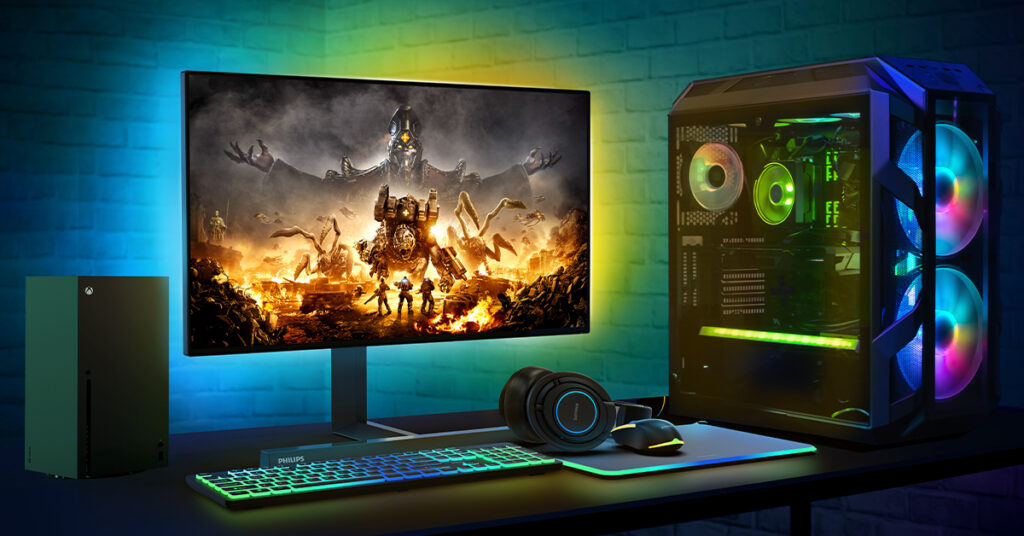The perfect WFH solution for gamers – KVM
Gamers who just use one console and one monitor for gaming have their hardware setups pretty figured out as far as configuration. But what happens when you want to add more devices to the mix?

A Common Problem
During the last two years, working from home becomes the norm for the majority. This often creates situations where one set of devices was used for gaming and another set of devices was used for working. Or even more troubling – the constant switching of cables as the users unplugged their laptops from monitors to plug in their gaming consoles, or vice-versa.
Ideally, there should be a way that the same monitor, keyboard and mouse (or other controllers) can be used with both a computer and a gaming console, or with two computers (one for gaming, one for working).
The Solution
Fortunately, this common scenario has been addressed, and the way it’s typically handled is with a keyboard, video and mouse (KVM) switch. Very simply, a KVM switch allows a person to use just one monitor, keyboard and mouse (or another type of controller, usually USB) with multiple devices. It uses multiple sets of cables in a “Y”-type configuration so that a gamer/worker only has to have one set of hardware on their desk. It’s a way of simplifying your setup so that, once configured, you don’t need to touch it again; there’s no more plugging in or unplugging of cables needed, and no need to have two of everything (monitors, keyboards and mice/controllers).
KVM Switches in Monitors
It’s common to see KVM switches sold in stores and online, but now, a new phenomenon has made life even more convenient, as some monitors have started to incorporate their own KVM switches internally. The Philips Momentum 279M1RV and 329M1RV monitors, for example, are two such monitors with their own built-in KVMs, and they were specifically designed for gaming (especially optimum Xbox gaming) in collaboration with the Microsoft Xbox development team.
Each of these monitors has a built-in USB hub, with four USB inputs. There are also three HDMI 2.1 inputs, a DisplayPort 1.4 input and a powered USB-C input/output. The DisplayPort can use G-SYNC to sync (with variable refresh rate and NVIDIA-certified compatibility) to the graphics card in your PC for big-screen, 144Hz refresh-rate 4K gaming, without screen tearing or performance lagging.
The HDMI inputs of the Momentum monitors also support fast variable refresh rates of up to 120Hz in 4K resolution, for clear, fluid gaming with Xbox Series X and other consoles. The USB-C input on these monitors features DisplayPort Alt Mode, which allows the USB-C connection to be used as a second DisplayPort for high-definition video. The connection also supports 65-watt Power Delivery (PD65W), for charging portable devices like laptops, tablets and smartphones.
How the Philips Momentum Monitors Connect
If you have, say, an Xbox and a PC, your Xbox can connect to one of the Philips monitors via HDMI and the USB Up port, and your PC can connect to the same monitor simply with USB-C (USB-C can carry both monitor and USB data signals). Or, if you’re using two PCs, one of them can connect via USB-C, and the other can connect via DisplayPort and the USB Up port. When you’re using two devices, you can even view the signal from both of them simultaneously on the same monitor via the Multiview Picture by Picture (PBP) mode; this is ideal for streamers and content creators.
The Upshot
In conclusion, the Philips Momentum Monitors deliver stunning high-resolution images, low latency (extremely high refresh and frames-per-second [FPS] rates, with fewer dropped frames) and KVM capabilities in one convenient, integrated package. They’re ideal for use with Xbox and other gaming consoles, as well as PCs, whether you’re playing, working or doing both.
